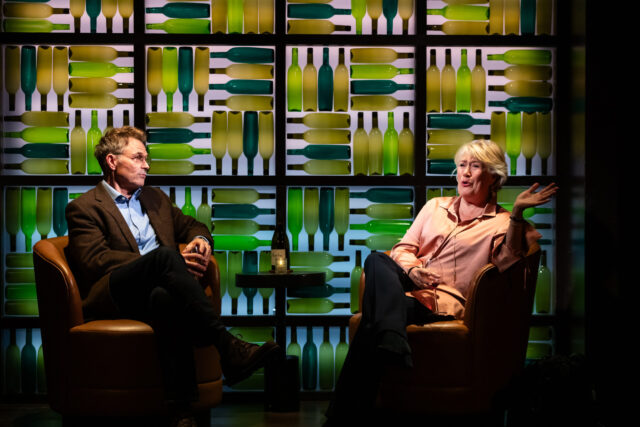
Mark (Tim Daly) and Helen (Jayne Atkinson) go over old times in Lia Romeo’s Still (photo by Joey Moro)
STILL
DR2 Theatre
103 East 15th St. at 20 Union Sq. East
Extended through May 23, $36.50-$90
www.coltcoeur.org/still
During the pandemic, I watched Lia Romeo’s lovely Zoom play Sitting & Talking, in which a pair of septuagenarians, a gruff divorcé and an elegant widow, portrayed by TV favorites Dan Lauria and Wendie Malick, respectively, try to make a connection online. Romeo’s latest, Still, is a lovely in-person play in which a pair of sexagenarians, a gentle divorcé and a never-married writer, portrayed by TV favorites Tim Daly and Jayne Atkinson, spend one night sitting and talking, trying to reconnect and, perhaps, rekindle an old relationship.
Continuing at the intimate DR2 Theatre through May 23, the seventy-five-minute Colt Coeur production takes place in a hotel, where Mark (Daly) and Helen (Atkinson) meet for the first time in decades. Mark is a sixty-seven-year-old bank lawyer who has just gotten divorced after twenty-nine years of marriage; Helen is a sixty-five-year-old bestselling novelist. He has two daughters; she has no children.
Their conversation in the lounge ranges from past memories to current dreams to aging and ailments. “You know what I’ve heard?” Helen begins. “The cells in your body completely renew themselves every seven years. I mean they’re all renewing themselves all the time, obviously, but after seven years you’re a completely different person. On a cellular level.” It’s a potent comment about how people change over time, no matter how much they might think they are the same, shortly followed by this poignant exchange:
Mark: You haven’t changed much.
Helen: You don’t think so? I was scared, getting dressed, that you’d think I looked so —
Mark: No, no, you look great.
Helen: Great for my age, maybe, but I look terrible for forty. How old are you in your head?
Mark: What do you —
Helen: Like when you picture your face — and then you see your real face — do you get surprised?
Mark: I think maybe I’m fifty.
Helen: I think I’m even younger than that. I think I’m probably around the age when you last saw me.
Mark: You don’t look that different.
Helen: You didn’t know me.
Mark: What?
Helen: When you first came in — I was sitting here, you walked right past the table. I had to say “Mark!” —
Mark: It was dark!
Helen: You thought — who’s that shriveled-up woman. That little old woman — that can’t be Helen —
Mark: That’s not what I thought!
Helen: It’s okay. I thought you looked old, too.
Mark: You did?
Helen: Not in a bad way. Men age better than women.
Mark: That’s bullshit.
Helen: I know! I know it is, but I still feel it.
They discuss dating, Tinder, poetry, being sick, happiness, who broke up with whom all those years ago, and why they hadn’t stayed in touch. He says, “Sometimes I feel like everything could have been different. I mean — if you and I — I know we wanted different things —” She replies lightly, “Yeah, I wanted you, and you wanted someone else.”
But after Mark asks Helen to come upstairs to his hotel room, a disagreement — about the immediate future and the book Helen is currently writing — places a potential roadblock in their relationship.
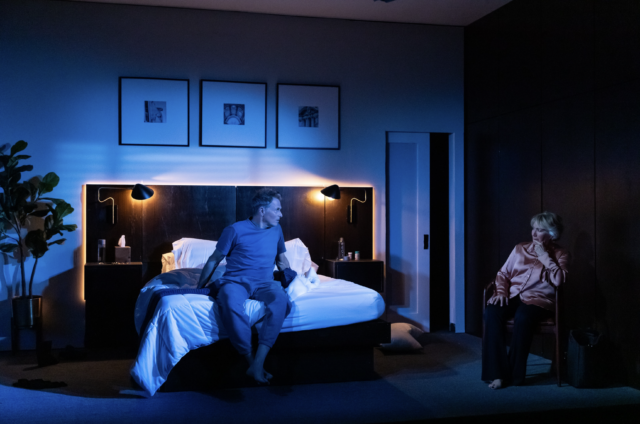
Tim Daly and Jayne Atkinson excel in moving play about love, loneliness, and aging (photo by Joey Moro)
Romeo (Connected, Green Whales) has crafted a tender, insightful work that explores what was, what is, and what still might be, directed by Adrienne Campbell-Holt (Dodi & Diana, Eureka Day) with a graceful delicacy even as things heat up. Alexander Woodward’s sets are cozy, with soft lighting by Reza Behjat and warm sound by Hidenori Nakajo, inviting the audience into the caring story; Barbara A. Bell’s costumes are naturalistic at first but then grow bold in the second half.
Mark and Helen are believable, well-developed characters in relatable situations. They’ve been through good times and bad, now wondering if they might be able to have the future they once considered so long ago. Emmy nominee Daly (Coastal Disturbances, Downstairs) and two-time Tony nominee Atkinson (The Rainmaker, Enchanted April) give beautifully nuanced performances as two proud individuals taking stock of their lives, wondering what comes next and whether they are still prepared to take chances and make changes to their relatively comfortable existence as senior citizens.
“It’s all kind of a crapshoot, at our age,” Mark says.
But Still wisely shows us that it doesn’t have to be.
[Mark Rifkin is a Brooklyn-born, Manhattan-based writer and editor; you can follow him on Substack here.]
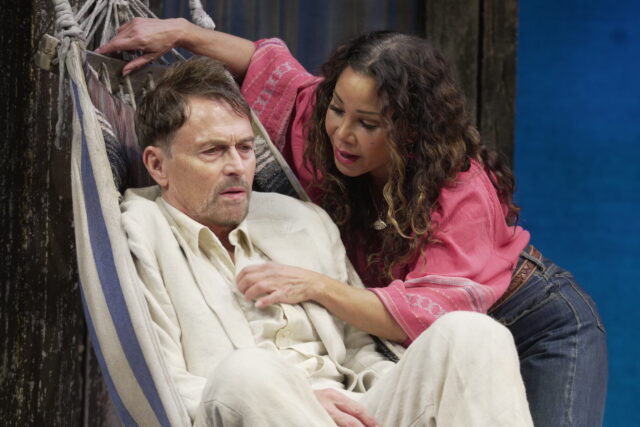
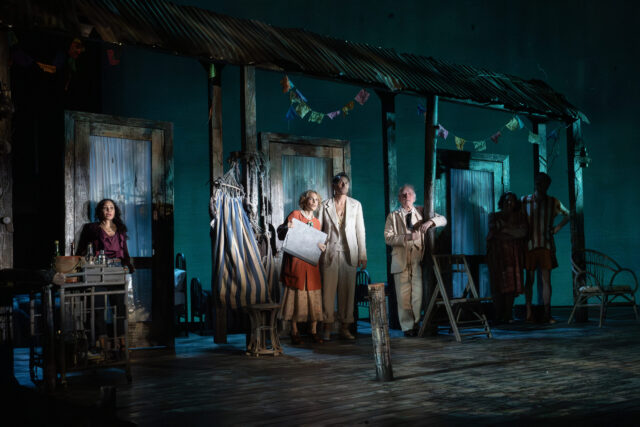
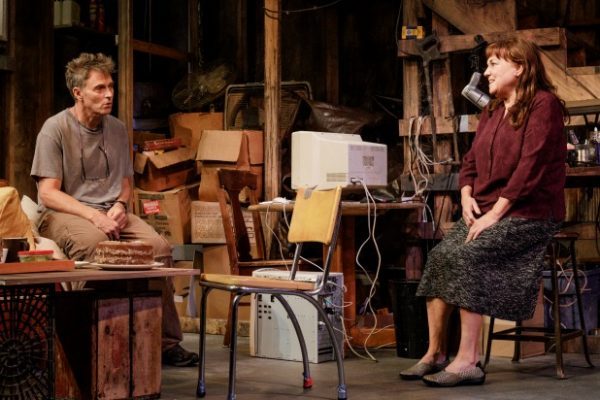
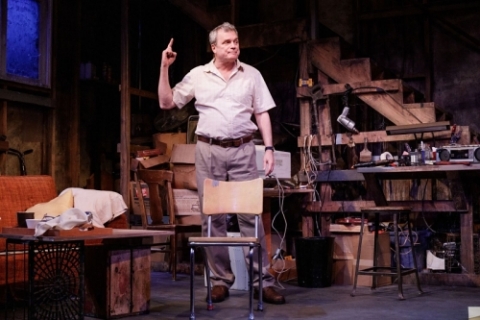
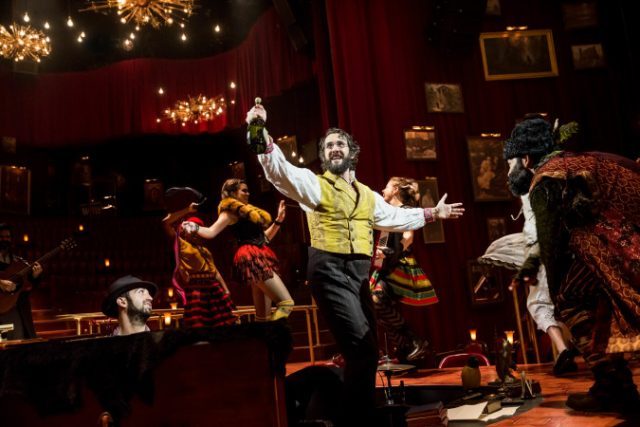
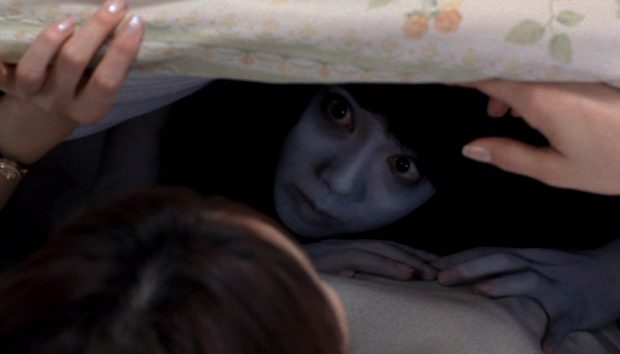
 “Black cats feature in the mythology of many cultures, and superstitions about them are still familiar to most of us in modern times. They are a prime example of the contrariness of many of our superstitious beliefs; some swear they’re lucky, others see them as a sign of certain doom,” Chloe Rodes writes in Black Cats and Evil Eyes: A Book of Old-Fashioned Superstitions. BAMcinématek certainly had the latter in mind when it programmed its Halloween series “13 Cats,” a baker’s dozen of feline horror stories running through November 3 at BAM Rose Cinemas. The frightfest kicked off October 21-23 with the Hayao Miyzazaki favorite Kiki’s Delivery Service and also includes the Nobuhiko Obayashi cult classic Hausu, Roger Corman’s The Tomb of Ligeia, David Lowell Rich’s Eye of the Cat, Kaneto Shindô’s Kuroneko, and both Jacques Tourneur’s and Paul Schrader’s Cat People. On October 27, Takashi Shimizu’s Ju-On: The Grudge will cross movie fans’ path in Brooklyn. After making two Ju-Ons for Japanese video, Shimizu wrote and directed this feature-length haunted-house movie that he later also turned into an American version starring Sarah Michelle Gellar. A terrifying ghost (Takaka Fuji) who emits bizarre sounds keeps killing just about anyone who enters her suburban home, where a husband murdered his wife and their black cat, and their young son went missing. But don’t worry; the white-faced kid (Yuya Ozeki) continually shows up in the strangest of places, as does a very creepy woman. (Don’t look under the sheets.) The more Rika (Megumi Okina) gets involved, the spookier things get. And poor Izumi (Misa Uehara) and Hitomi (Misaki Itô). You’re likely to have trouble falling asleep after watching this truly scary, extremely confusing film, which Shimizu was afraid would be too laughable.
“Black cats feature in the mythology of many cultures, and superstitions about them are still familiar to most of us in modern times. They are a prime example of the contrariness of many of our superstitious beliefs; some swear they’re lucky, others see them as a sign of certain doom,” Chloe Rodes writes in Black Cats and Evil Eyes: A Book of Old-Fashioned Superstitions. BAMcinématek certainly had the latter in mind when it programmed its Halloween series “13 Cats,” a baker’s dozen of feline horror stories running through November 3 at BAM Rose Cinemas. The frightfest kicked off October 21-23 with the Hayao Miyzazaki favorite Kiki’s Delivery Service and also includes the Nobuhiko Obayashi cult classic Hausu, Roger Corman’s The Tomb of Ligeia, David Lowell Rich’s Eye of the Cat, Kaneto Shindô’s Kuroneko, and both Jacques Tourneur’s and Paul Schrader’s Cat People. On October 27, Takashi Shimizu’s Ju-On: The Grudge will cross movie fans’ path in Brooklyn. After making two Ju-Ons for Japanese video, Shimizu wrote and directed this feature-length haunted-house movie that he later also turned into an American version starring Sarah Michelle Gellar. A terrifying ghost (Takaka Fuji) who emits bizarre sounds keeps killing just about anyone who enters her suburban home, where a husband murdered his wife and their black cat, and their young son went missing. But don’t worry; the white-faced kid (Yuya Ozeki) continually shows up in the strangest of places, as does a very creepy woman. (Don’t look under the sheets.) The more Rika (Megumi Okina) gets involved, the spookier things get. And poor Izumi (Misa Uehara) and Hitomi (Misaki Itô). You’re likely to have trouble falling asleep after watching this truly scary, extremely confusing film, which Shimizu was afraid would be too laughable.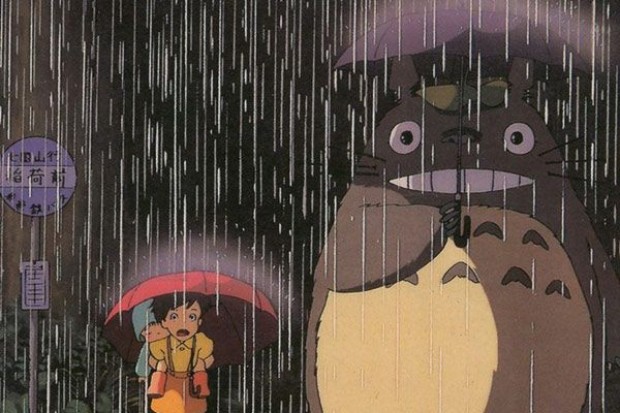
 In many ways a precursor to Hayao Miyazaki’s masterpiece, Spirited Away, the magical My Neighbor Totoro is a fantastical trip down the rabbit hole, a wondrous journey through the sheer glee and universal fears of childhood. With their mother, Yasuko (voiced by Lea Salonga), suffering from an extended illness in the hospital, Satsuki (Dakota Fanning) and her younger sister, Mei (Elle Fanning), move to a new house in a rural farming community with their father, anthropology professor Tatsuo Kusakabe (Tim Daly). Kanta (Paul Butcher), a shy boy who lives nearby, tells them the house is haunted, and indeed the two girls come upon a flurry of black soot sprites scurrying about. Mei also soon discovers a family of totoros, supposedly fictional characters from her storybooks, living in the forest, protected by a giant camphor tree. When the girls fear their mother has taken a turn for the worse, Mei runs off on her own, and it is up to Satsuki to find her. Working with art director Kazuo Oga, Miyazaki paints My Neighbor Totoro with rich, glorious skies and lush greenery, honoring the beauty and power of nature both visually as well as in the narrative. The scene in which Satsuki and Mei huddle with Totoro (Frank Welker) at a bus stop in a rainstorm is a treasure. (And just wait till you see Catbus’s glowing eyes.) The movie also celebrates the sense of freedom and adventure that comes with being a child, without helicopter parents and myriad rules suffocating them at home and school. (Note: BAM will be screening the English-language version in the “13 Cats” series.)
In many ways a precursor to Hayao Miyazaki’s masterpiece, Spirited Away, the magical My Neighbor Totoro is a fantastical trip down the rabbit hole, a wondrous journey through the sheer glee and universal fears of childhood. With their mother, Yasuko (voiced by Lea Salonga), suffering from an extended illness in the hospital, Satsuki (Dakota Fanning) and her younger sister, Mei (Elle Fanning), move to a new house in a rural farming community with their father, anthropology professor Tatsuo Kusakabe (Tim Daly). Kanta (Paul Butcher), a shy boy who lives nearby, tells them the house is haunted, and indeed the two girls come upon a flurry of black soot sprites scurrying about. Mei also soon discovers a family of totoros, supposedly fictional characters from her storybooks, living in the forest, protected by a giant camphor tree. When the girls fear their mother has taken a turn for the worse, Mei runs off on her own, and it is up to Satsuki to find her. Working with art director Kazuo Oga, Miyazaki paints My Neighbor Totoro with rich, glorious skies and lush greenery, honoring the beauty and power of nature both visually as well as in the narrative. The scene in which Satsuki and Mei huddle with Totoro (Frank Welker) at a bus stop in a rainstorm is a treasure. (And just wait till you see Catbus’s glowing eyes.) The movie also celebrates the sense of freedom and adventure that comes with being a child, without helicopter parents and myriad rules suffocating them at home and school. (Note: BAM will be screening the English-language version in the “13 Cats” series.)